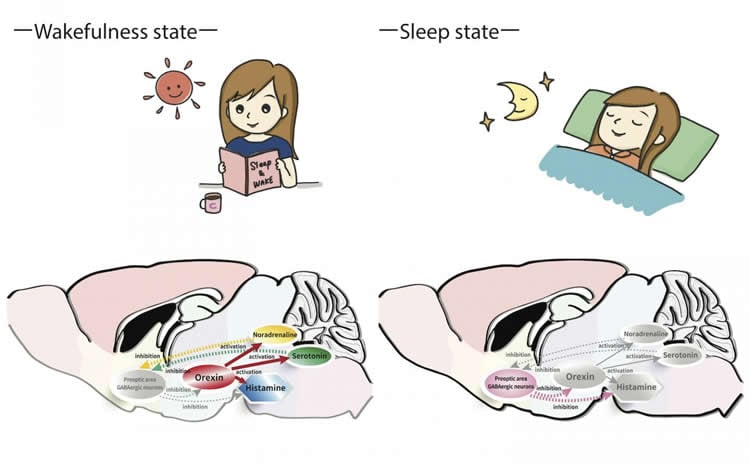Summary: Researchers have identified novel neural pathways that help regulate sleep and wakefulness.
Source: University of Tsukuba.
Sleep is an autonomic process and is not always under our direct, voluntary control. Awake or asleep, we are basically under the regulation of two biological processes: sleep homeostasis, commonly known as ‘sleep pressure’, and the circadian rhythm, otherwise known as the ‘body clock’. These two processes work in harmony to promote good consolidated sleep at night.
The ventrolateral preoptic nucleus (VLPO) in the brain plays a critical role in falling–and staying–asleep, while the lateral posterior part of the hypothalamus contains neurons (brain cells) that play a role in the maintenance of staying awake, including orexin neurons in the lateral hypothalamic area (LHA) and histaminergic neurons in the tuberomammillary nucleus (TMN). To date, however, the precise connectivities among these cell populations remain unclear.
“In our study, we aimed to identify the important players implicated in arousal regulation,” explains Yuki Saito, who co-led a University of Tsukuba-centered study recently reported in The Journal of Neuroscience.
“To achieve the study objective, we focused on populations of hypothalamic neurons, histidine decarboxylase-positive (HDC+) histaminergic neurons (HDC neurons) in the TMN and orexin neurons in the LHA,” adds co-lead author Takashi Maejima.

The team used recombinant rabies-virus-mediated trans-synaptic retrograde tracing in the mouse brain to analyze the architecture and function of hypothalamic circuits that link neuronal populations implicated in sleep/wakefulness regulation. They found that these arousal-related neurons are heavily innervated by GABAergic neurons in the preoptic area, including the VLPO.
The team further characterized GABAergic neurons in the VLPO (GABAVLPO neurons) that make direct synaptic contact with hypothalamic arousal-related neurons. These two groups of neurons were overlapped each other, and both potently inhibited by the hormones noradrenaline and serotonin, showing typical electrophysiological characteristics of sleep-promoting neurons in the VLPO.
“Taken together, our findings provide direct evidence of monosynaptic connectivity between GABAVLPO neurons and hypothalamic arousal neurons and identifies the effects of monoamines on these neuronal pathways,” says study corresponding author Takeshi Sakurai. “This information is important for us to gain a deeper understanding of mechanisms that control sleep and wakefulness, which may lead to the development of reliable recommendations for a restful sleep.”
Source: Masataka Watanabe – University of Tsukuba
Publisher: Organized by NeuroscienceNews.com.
Image Source: NeuroscienceNews.com image is credited to University of Tsukuba.
Original Research: Abstract for “Monoamines Inhibit GABAergic Neurons in Ventrolateral Preoptic Area That Make Direct Synaptic Connections to Hypothalamic Arousal Neurons” by Yuki C. Saito, Takashi Maejima, Mitsuhiro Nishitani, Emi Hasegawa, Yuchio Yanagawa, Michihiro Mieda and Takeshi Sakurai in Journal of Neuroscience. Published July 11 2018.
doi:10.1523/JNEUROSCI.2835-17.2018
[cbtabs][cbtab title=”MLA”]University of Tsukuba”A Peek Into the Interplay Between Sleep and Wakefulness.” NeuroscienceNews. NeuroscienceNews, 20 July 2018.
<https://neurosciencenews.com/sleep-wakefulness-9589/>.[/cbtab][cbtab title=”APA”]University of Tsukuba(2018, July 20). A Peek Into the Interplay Between Sleep and Wakefulness. NeuroscienceNews. Retrieved July 20, 2018 from https://neurosciencenews.com/sleep-wakefulness-9589/[/cbtab][cbtab title=”Chicago”]University of Tsukuba”A Peek Into the Interplay Between Sleep and Wakefulness.” https://neurosciencenews.com/sleep-wakefulness-9589/ (accessed July 20, 2018).[/cbtab][/cbtabs]
Abstract
Monoamines Inhibit GABAergic Neurons in Ventrolateral Preoptic Area That Make Direct Synaptic Connections to Hypothalamic Arousal Neurons
The hypothalamus plays an important role in the regulation of sleep/wakefulness states. While the ventrolateral preoptic nucleus (VLPO) plays a critical role in the initiation and maintenance of sleep, the lateral posterior part of the hypothalamus contains neuronal populations implicated in maintenance of arousal, including orexin-producing neurons (orexin neurons) in the lateral hypothalamic area (LHA) and histaminergic neurons in the tuberomammillary nucleus (TMN). During a search for neurons that make direct synaptic contact with histidine decarboxylase-positive (HDC+), histaminergic neurons (HDC neurons) in the TMN and orexin neurons in the LHA of male mice, we found that these arousal-related neurons are heavily innervated by GABAergic neurons in the preoptic area including the VLPO. We further characterized GABAergic neurons electrophysiologically in the VLPO (GABAVLPO neurons) that make direct synaptic contact with these hypothalamic arousal-related neurons. These neurons (GABAVLPO→HDC or GABAVLPO→orexin neurons) were both potently inhibited by noradrenaline and serotonin, showing typical electrophysiological characteristics of sleep-promoting neurons in the VLPO. This work provides direct evidence of monosynaptic connectivity between GABAVLPO neurons and hypothalamic arousal neurons and identifies the effects of monoamines on these neuronal pathways.
SIGNIFICANCE STATEMENT Rabies-virus-mediated tracing of input neurons of two hypothalamic arousal-related neuron populations, histaminergic and orexinergic neurons, showed that they receive similar distributions of input neurons in a variety of brain areas, with rich innervation by GABAergic neurons in the preoptic area, including the ventrolateral preoptic area (VLPO), a region known to play an important role in the initiation and maintenance of sleep. Electrophysiological experiments found that GABAergic neurons in the VLPO (GABAVLPO neurons) that make direct input to orexin or histaminergic neurons are potently inhibited by noradrenaline and serotonin, suggesting that these monoamines disinhibit histamine and orexin neurons. This work demonstrated functional and structural interactions between GABAVLPO neurons and hypothalamic arousal-related neurons.






